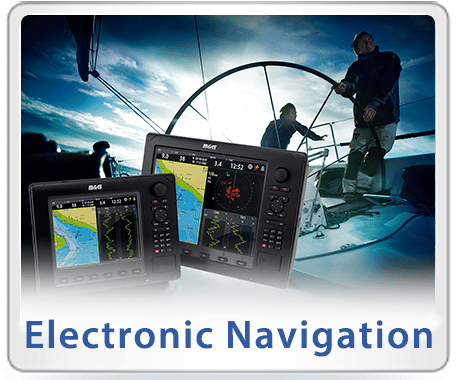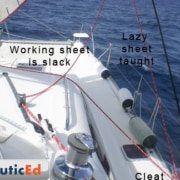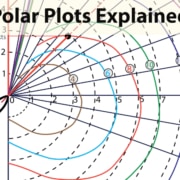What is VMG?
VMG – Velocity Made Good and Polar Plots
This discussion comes mostly out of our Electronic Navigation Course which is available also as an iPad Electronic Navigation Course App.
For sailboats, VMG is slightly different than what you’d expect if you were navigating an airplane or power boat. For airplanes and powerboat VMG is your velocity in the direction of your destination. It can differ from your actual velocity because of wind in the case of an airplane or current in a powerboat. But with no wind or current, your VMG is equal to your vessel speed.
In a sailboat – VMG is the velocity component of the boat in an upwind (or downwind) direction. The distinction is made because sailboats inherently can not head in an upwind direction but it is important information to know. And as you’ll know soon a sailboat can reach a downwind destination faster if it bears off a little rather than heading dead downwind. Thus some manufacturers make the distinction between power and sail by using the defined terms VMC and VMG.
VMC is the Velocity Made good on Course. i.e. Speed in the direction of the mark.
VMG is the Velocity Made Good i.e. Speed in the upwind of downwind direction.
Some manufacturers don’t bother with us sailors and some manufacturers do but don’t use VMC . The trick is to just know the difference and know what information you are looking at.
Since Manufacturers don’t distinguish – in this post we have attempted to point out each time if VMC or VMG is being used.
It is important to point out that these methods were the only choice in the days before PCs, mobile devices and GPS. We’ll go through the original method below for your understanding, but there are simpler, faster, low-cost methods available now. For example, the SailTimer Charts Edition app is free in the US. Simply by entering your waypoint and the wind speed and direction, it will overlay your optimal tacks on the chart and tell you your Tacking Time to Destination.
Here below we have created an interactive animation to help understand this concept with a dual benefit of learning how a polar plot for a sailboat works. If you’re new to sailing – don’t worry – this explanation will teach you a lot about sailing and you’ll come out knowing more on this topic than most sailors – mostly because of poor existing textual explanations of polar plots. Yay – go NauticEd interactive animations!
A polar plot is simply a graph of the boat’s speed in all different wind directions. In the old days, if you were a sponsored racing team, you could spend a lot of money on a computer simulation to get a polar plot of your boat’s estimated speeds, if you provided the boat model, hull shape, displacement, length and so on. A few manufacturers also provided these (although naturally the manufacturers may be overly optimistic about their boat’s performance in marketing materials). Fortunately, in the age of GPS, an app like the SailTimer app can easily record your boat’s speed in various wind conditions and generate a custom polar plot for your individual boat. That is actual data, not generic polars for all boats of a particular model, estimates or marketing materials. That gives you the most reliable indicator of boat speeds for determining tacking angles and arrival times.
When you click on any of the numbers in the green stripe, the sailboat moves to that angle of attack to the true wind. Go ahead and click around randomly a little to start with. Note that the boat will lie on the backwards facing strange looking “C” curve anytime you click on a wind angle. For example, if you click on 90, the boat will move to the outer right of the C curve and lie on the 90 degree line. Simultaneously, you’ll notice that the wind meter below also represents the true wind angle and shows the boat speed. And one more thing – notice that we have also overlaid the optimum position of the sails according to the wind angle for you new sailors.
Understanding the Polar Plot
Alrighty then, let’s work through this logically. One thing that always perplexes new sailors (and some old) is what is the best angle to sail at to get to an upwind destination the fastest. Do you sail close to the wind but with lower speed or do you trade out angle with a higher speed? The answer lies directly in a polar plot. A polar plot C curve is a graph that is plotted unique to each boat type and the C curve follows the performance of that boat at a specific true wind speed AND assuming that the sails are set at their optimum. For example, in the polar plot presented here, if you click on 60 degrees the boat speed will be 8 knots as shown by the wind meter AND also found by following the arc of the polar plot around to the vertical speed line. Similarly, 90 degrees will also render 8 knots. 150 degrees 6.9 knots. With each angle, all you do is follow an arc starting from the intersection of the C curve and the radial angle line around to the vertical line. Simple!
VMG Upwind
Back to the question at hand – which is the best angle to head to get the fastest upwind or downwind speed? Well, notice that when you click on an angle on the green stripe the wind meter gives boat speed. This is speed through the water in the direction the boat is pointing. But it’s not giving the VMG (velocity of the boat in an upwind direction). Many high-tech GPS Chart plotters (like the B and G Zeus discussed in the Electronic Navigation Course) do display VMG automatically these days and they distinguish between VMG and VMC.
Unfortunately, most other chart plotters do not clarify whether their display of VMG refers to Velocity to the Mark (VMC) or to the Wind (VMG). Velocity to the Mark works in aircraft, vehicles and powerboats, but is not correct when used on sailboat tacks (see www.SailTimerApp.com/VMG.html for a full explanation). This could be a dangerous situation, so you should only use VMG on chartplotter hardware if it actually specifies that it is VMG to the Wind that is being displayed. VMG to the Mark (VMC) is useful on powerboats, but it not meaningful or reliable on sailboats when tacking to an upwind waypoint.
From the polar plot, it’s also easy to find the VMG because by definition of sines and cosines of the angles if you draw a line horizontally across to the vertical speed line – that is your VMG. For an easy example – if your boat was heading 90 degrees to the true wind – obviously you’re not making any upwind headway. From the plot, the 90 degree line renders zero at the vertical speed line – of course. Now look at 80 degrees, You’d be making 2 knots VMG with 8 knots boat speed. Once you grasp this its easy to see exactly what renders the highest VMG. Its a horizontal line that is the highest on the plot that barely touches the C curve. e.g. click on 40 degrees. You’ll see that this renders the best VMG of 5.2 knots whilst the boat is doing 6.9 knots. No other horizontal line can be higher that touches the C curve.
So here we have answered the question of should I head more upwind and lose speed or crack off a little and while losing angle to gain speed. The answer is right in the polar plot. Draw a horizontal line tangent to the top of the polar plot then bring a radial line down to the center and measure that angle. Traditionally, that’s the true wind angle you give to your helmsperson to sail to in order to beat the competition. Know however that this is true wind angle not apparent wind angle. AND also know however that, as easy as it may seem for an electronic device to calculate, true wind determination is not that easy – see the discussion on this in our Electronic Navigation Course. At this angle, you also give the theoretical boat speed number to your sail trimmers. If your boat is not at this speed than according to the manufacturer, you’re not trimmed optimally.
Of course, unless you have a full-time tactician on board, and an accurate display/calculation of true wind it is not really practical to be working with a polar plot so hard. But the SailTimer app is an example of a modern program that can do precise calculations automatically, to show you the optimal tacking angles based on the actual polar data for your individual boat, along with the distance on each tack and the overall Tacking Time to Destination (TTD).
The SailTimer tacking results do not rely on VMG or raise questions about whether you are using VMG to the Mark (VMC) or to the Wind (VMG), it simply finds the fastest route based on tacking distances and boat speeds from your polar plot. One of the other disadvantages of any VMG is that it can only be calculated while you are actually moving. In contrast, you can get the free Sailtimer app and plan out tomorrow’s trip at your desk or on the dock before you go, to see the optimal tacks and TTD (Time to Destination) for any given wind forecast.
VMG Downwind
So now take a look at the downwind sailing scenario. If you click on 180 degrees you’ll see that the boat is making 5.1 knots direct down wind. But what if the helmsperson cracked off some to try to add in some positive apparent wind effect? You can see that the C curve dips down most out at 140 degrees. This will render a higher boat speed of 8 knots AND a higher downwind VMG of 5.7 knots compared to 5.1 at 180. 5.7 comes from the horizontal line touching the lowest point of the C curve. Where that intersection occurs you measure the angle around the polar plot, giving 140 degrees in this instance.
WOW so it is true! Heading off at an angle downwind will get you home faster. YUP and the proof is right here in the polar plot not on the water (so long as your polar plot looks like this).
With on board electronic devices that are properly tuned, you can view some pretty amazing information. This information can really make a difference to performance speed. The NauticEd Electronic Navigation course uses the B and G Zeus device as an example of an excellent piece of equipment that you’d be well served to have on board. The course takes you through the whole device as an example of most any manufacturers equipment and shows all the theory behind the information you are being feed. You’ll also learn how to get into the screen guts and display the right information that is pertinent to your desires.
These days, sailboat navigation apps are also evolving quickly. The SailTimer app is one example that can graph the day’s wind speed, display your GPS track, and show your optimal tacks (see www.SailTimerWindVane.com/iOSapp.html).
As one other illustration of how marine electronics and sailboat navigation have changed in the digital age, we can also look at “ETA”. That is a common term that many people refer to; Estimated Time of Arrival. But if you have ever used a GPS chartplotter when on a long tack, you may have wondered how accurate the ETA display actually is. Does the device know when you are going to tack, or your tacking distances? If not, how can it display a correct ETA? This is why this course is invaluable for you. Although ETA is widely used on GPS chartplotters and pretty much all sailboats, sometimes the established methods take a long time to change, even if they are based more on marketing than accurate information. Since some GPS chartplotters don’t know your tacking distances, many in fact use the traditional method of calculating your VMG to the Mark (VMC), to estimate your ETA. But VMG to the Mark is not reliable in sailboats. Fortunately, with apps like the free SailTimer app (www.SailTimerApp.com), you can easily display your Tacking Time to Destination (TTD) instead of ETA.
Take the NauticEd Electronic Navigation Course now – even if you don’t have a boat or electronics on board – you’ll learn a lot about sailing and navigation which will be helpful for Bareboat Charter Sailing Vacations and understanding what navigation/heading decisions the captain is making regarding VMG and other information.
Here is the iPad Electronic Navigation Course App

Electronic Navigation Course






